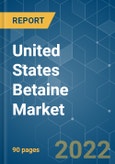The United States betaine market is expected to witness a CAGR of about 4% during the forecast period. The major factors driving the growth of the market studied are its increased commercial usage as a surfactant and increasing demand from the personal care industry.
Key Highlights
- On the flip side, synthetic cosmetics leading to skin and hair problems serves as one of the restraints for the studied market.
- The personal care segment dominated the market and is expected to grow during the forecast period, with increasing hygiene awareness and increasing demand for cosmetic products.
Key Market Trends
Growing Usage in the Food and Beverage Industry
- The use of betaine in the food industry has increased over the past few years, due to rising consumer awareness about health benefits related to the consumption of betaine.
- It is majorly used in functional drinks to increase nutritional value. In addition, it is also used in dietary supplements (in the form of anhydrous betaine) due to its ability to supply the body with TMG. TMG is a nutrient that induces a feeling of well-being in the human body and improves the mood of an individual, by S-Adenosyl methionine formation. FDA has approved the usage of betaine hydrochloride in dietary supplements.
- Apart from the aforementioned benefits, consumption of betaine provides the following benefits to the human body:
- Increases lean muscle mass and reduce body fat
- Protects homocysteine (homocysteine levels are used to study the health of heart and blood vessels)
- The food and beverage industry is expected to boom with the ongoing shift in food preference, worldwide. Demand for processed and ready-to-eat foods, particularly frozen foods, is growing across Asia, as increasingly time-pressed consumers have embraced the convenience of the freezer and microwave cooking.
- The United States witnessed the highest growth rate in the frozen food market globally, fuelled by the changing eating habits of the populace. In the United States, more than 60% of the diet consists of highly processed food, indicating significant demand in the market.
- Innovative marketing strategies are imperative to penetrate the market. The growth of tourism and the hotel and restaurant sectors will require a greater array of frozen materials and ingredients, to make final products more appealing to foreigners and fast changing domestic consumer tastes and preferences.
- However, the country has been looking forward to reduce the consumption of processed food due to increasing health problems, such as obesity, diabetes, digestion problems, etc. However, reduction in the consumption of processed food in the United States at noticeable pace, is expected to grow only in the run by driving the demand for the market studied.
- In recent times, due to the COVID-19 pandemic, the country was under temporary lockdown through the first quarter of 2020, thereby hinder the growth of various sectors. However, the market is expected to recover by the end of 2020 and continue to grow through the forecast period.
Personal Care Segment to Dominate the Market Demand
- Betaine is extensively used in the personal care industry as an alternative to sulfur-based surfactants. It acts effectively as an irritation mitigating agent used in baby shampoos and ultra-mild personal care products.
- Water retention and moisturizing properties of betaine make it widely useful raw material for the cosmetic industry. Besides, it is widely used as a surfactant, emulsifier, and emollient in personal care products, such as lotions, shampoos, skin cleansers, intimate cleansers, and shaving products, among others.
- Some of the properties of betaine for which it is used in the personal care application includes:
- Acts as an anti-irritant in formulated products
- Alkyl and alkyl ether sulfate-free
- Amide-free formulating option
- Excellent choice for sulfate-free formulaitng
- Excellent detergency and viscosity
- Foam booster and thickener
- Gentle cleansing
- According to the L'Oreal annual report, United States accounts for the largest share in the cosmetics market in the North America region and second largest globally. Skin care accounts for the largest market share in the cosmetics market, with hair care being the second-largest, followed by makeup and fragrances products in the market.
- However, the industry faced a slowdown due to the outbreak of COVID-19. The cosmetics and toiletries of the country is expected to experience a high level of decline which is almost a record decline in the last 60 years, according to industry experts. Temporary lockdown, social distancing, and consumer spending are the key parameters which is expected to hamper the growth of the market in recent times.
- Therefore, the consumption of betaine in personal care application is expected to reduce in the near future. However, the situation is expected to recover in the first half of 2021 and continue to grow through the forecast period.
Competitive Landscape
The United States betaine market is moderately consolidated in nature, with the top players accounting for a significant share of the market. Some of the noticeable players in the market include DuPont, Evonik Industries AG, Solvay, Stepan Company, and Kao Corporation, amongst others.
Additional Benefits:
- The market estimate (ME) sheet in Excel format
- 3 months of analyst support
This product will be delivered within 2 business days.
Table of Contents
Methodology

LOADING...








